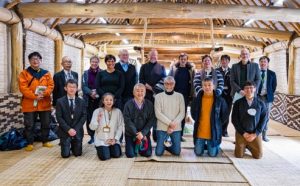Memoir (13) by Dr. Zhang Tianxin, Peking University, China
In the middle of January 2023, I visited GSI in Hokkaido University to continue my research works on indigenous studies. The main task was to attend and present at the GIS seminar that was scheduled for 21st-22nd Jan, 2023. The whole process showed the importance of a good combination of international and local cooperations.
After I arrived in Sapporo, several related activities were waiting for me. On 18th Jan, all the members arrived. They were a good mix of people from different regions and backgrounds, from Europe, America, Australia to Asia, from university professors to museum researchers. There were even several Indigenous people from different local regions.
One day before the seminar, on 19th, Prof. Kato led all the seminar participants to visit Nibutani village in the Sarugawa river basin, Biratori town. This was a concentration place of multiple Ainu culture facilities. We visited the Nibutani Ainu Culture Museum, the Historical Museum of the Saru River, the Nibutani Craft Center, the Nibutani Kotan (kotan means community/village in the Ainu language), Nokapiraiuoro Visitor Center, and had lunch at the Biratori Onsen Yukara. There were also many other facilities and shops that were worth visiting. They are operated and maintained by different subjects, ranging from the city to voluntary groups, showing a wide variety of themes and interests. Thanks for all these people’s efforts, this area was designated as a Cultural Landscape Property by the Japanese government, and is regarded as a model of Ainu community involvement in its development.
In the evening of the 20th, the symposium began with a keynote presentation by Professor Stanley Ulijaszek from Oxford University. Then it continued on the 21st and 22nd, and all the guest speakers gave their talks on experiences and lessons from most the main continents. The talks ranged from nutrition, archaeology, cultural landscapes, to tourism. One important feature of the symposium is that it invited several local scholars and administrators who work on Ainu culture to share their works, and there were also many Ainu people in the audiences. These made the event a great chance to share both international and local experiences related with Indigenous culture.
As for my own presentation, it was also the result of international collaboration. I talked on Satokibi in Okinawa and the Amami Islands as an important cultural landscape. This was a collaborative research between me and Prof. Yamamura Takayoshi, based on the findings and thoughts of our site investigation for Okinawa islands in 2022. Many of my other contacts in Hokkaido University, such as Professors Tashiro, Okada, Ueda, Yamasaki, Edelheim, Amada, and Ishikuro, were also very helpful in the whole process.
After the seminar, the international participants headed for Osaka on the 23th, and visited the National Museum of Ethnology and the Osaka Castle Park and Museum on the 24th. The experts met with the Head and staff members of the museums and discussed future possible research interests. I regard this as an important beginning of further international collaborative works.
Although the time for this event was short, it gave me a deep impression that GSI is becoming a “hub” for international experts on Indigenous Studies to gather and to communicate, and more productive outcomes can be expected to happen. Thanks to the current internet environment, although I returned home, I still feel that I am in GSI. And even so, I do expect to come back to GSI physically in the near future, because of its magic power to attract different people and inspire new thoughts.
 GSI members and friends visiting Biratori Town
GSI members and friends visiting Biratori Town
Photo courtesy of Dr. Sven Haakanson, University of Washington


